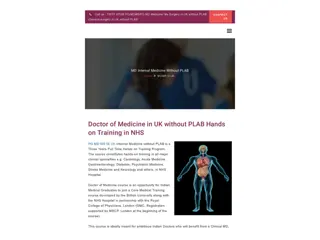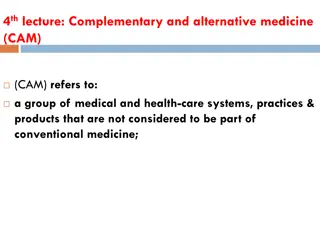
Influence of Whole Body MRI on Multiple Myeloma Treatment Decisions
Explore the impact of whole-body magnetic resonance imaging (MRI) in newly diagnosed multiple myeloma (MM) and its influence on treatment decisions. Findings suggest that advanced imaging techniques like MRI and PET-CT detect more lesions compared to traditional methods, aiding in early diagnosis and treatment planning. Asymptomatic MM patients and those with bone pain benefit from MRI evaluation, which offers better sensitivity for detecting lytic bone lesions and extramedullary disease. Furthermore, whole-body MRI outperforms PET scans in assessing disease infiltration and can differentiate responders from non-responders early on, making it a valuable prognostic biomarker in MM management.
Download Presentation

Please find below an Image/Link to download the presentation.
The content on the website is provided AS IS for your information and personal use only. It may not be sold, licensed, or shared on other websites without obtaining consent from the author. If you encounter any issues during the download, it is possible that the publisher has removed the file from their server.
You are allowed to download the files provided on this website for personal or commercial use, subject to the condition that they are used lawfully. All files are the property of their respective owners.
The content on the website is provided AS IS for your information and personal use only. It may not be sold, licensed, or shared on other websites without obtaining consent from the author.
E N D
Presentation Transcript
Whole Body Magnetic Resonance Imaging in Newly Diagnosed Multiple Myeloma: Influence on Treatment Decisions Natalia Neparidze, MD Assistant Professor Section of Hematology Yale Cancer Center Yale University School of Medicine
Introduction Historically metastatic bone survey (MBS) standard radiographic test in multiple myeloma (MM) Limitations: lack of sensitivity Advanced imaging (MRI, or PET) more sensitive Reserved for select cases: Asymptomatic MM Plasmacytoma Patients with bone pain Compression fractures Focal neurologic deficit
Advanced Imaging for Evaluation of MM Meta-analysis comparison: MRI PET-CT CT Met Bone survey Lesions detected by MRI or PET Lesions detected by CT or MBS Up to 80% more lesions were detected by newer imaging techniques: MRI, PET, PET-CT when compared to bone survey Regelink Brit J Hematol 2013
MRI for Evaluation of Myeloma MRI detects focal lesions in 52% of pts w negative MBS Advantages Discrimination of NL and invaded BM Detection of extramedullary dz Evaluation of cord involvement Better sensitivity for lytic bone lesions Walker et al 2007
MRI Patterns of Marrow Involvement Five MRI patterns Focal Diffuse Combined diffuse and focal Normal BM Variegated or salt and pepper Terpos JCO 2011; Dimopoulos JCO 2015
Superiority of Whole Body MRI (WB-MRI) Paired scans PET and WB-MRI WB-MRI detects higher burden of MM than PET Increased ability to detect diffuse BM dz WB-MRI outperforms PET in the assessment of disease infiltration in iliac bones MRI should be the investigation of choice for detection of myeloma marrow infiltration Pawlyn et al ASH 2015; Leukemia 2016 WB-MRI fat fraction change at 8 wks of induction differentiates responders from non- responders early response and predictive imaging biomarker. Latifoltojar et al ASH 2015
MRI in Asymptomatic Multiple Myeloma (AMM) MRI as a prognostic biomarker SWOG S010 study- detection of multiple focal lesions on MRI increased risk of progression Abnormal signal on MRI associated with very high risk of AMM progression More than one lesion >5 mm considered symptomatic disease require therapy Dhodapkar 2014; Dimopoulos et al, 2015; Kastritis 2013
MRI in Asymptomatic Myeloma IMWG recommends WB-MR for: All patients w suspected AMM Solitary bone plasmacytoma Ideally WB-MRI MRI of total spine and pelvis when WB-MRI not available (50% lesions will be missed by imaging spine alone) Disadvantage of standard protocols of MRI : Prolonged acquisition time Difficult to perform in ill pts Claustrophobic pts Dimopoulos 2015; Bauerle 2009)
WB-MRI at Yale Need to advance newer methodologies / optimal imaging WB-MRI at YNHH Acquisition time 40 minutes Highly experienced musculoskeletal MRI radiologists Highly skilled in targeted bone biopsies /soft tissue biopsies Physicians at the Department of Radiology, performing MRI and image- guided biopsies: Elliott Brown, MD Andrew Haims, MD Andrew Lischuk, MD Jeffrey Weinreb, MD
Study Rational We predict that WB-MRI will outperform standard imaging in initial evaluation of MM and will influence treatment decisions Baseline MBS and WB-MRI were performed on newly diagnosed MM patients prior to initiation of therapy Multi-planar, multi-sequence WB-MRI was acquired without IV contrast The imaging studies were evaluated to determine their respective merits for disease staging and their impact on treatment decisions
Study Design Images reviewed by musculoskeletal Radiology group New Diagnosis of MM Standard evaluation Bone survey and WB-MRI Impact on staging and on treatment decisions was evaluated
Results WB-MRI detected MM lesions in 33% of pts (5/15) MBS detected lesions in only 6% (1/15) WB-MRI influenced staging in 73% of pts (11/15) WB-MRI impacted treatment decisions in 46% of pts (7/15) MBS missed MM lesions in 27% of pts (4/15) MM bone lesions occurred in the axial skeleton, mostly cervical, thoracic, lumbar spine and pelvis
Results MM Lesion Detection Test Characteristics 100 90 80 50 70 45 60 40 MBS % Patients 35 50 30 WB-MRI 40 25 30 20 20 15 10 10 5 0 0 Sens Spec PPV NPV WB-MRI MBS
Conclusion WB-MRI at diagnosis provides valuable information on the extent and the stage of the disease, significantly influences treatment decisions and is worth to be incorporated in initial diagnostic evaluation of patients with multiple myeloma.
Ongoing Efforts Prognostic significance of MRI Diffuse MRI pattern correlates with: High risk cytogenetics Advance ISS stage Increased angiogenesis Poorer OS Despite prognostic significance no treatment has been suggested for pts with high risk MRI pattern
Ongoing Efforts Role of MRI in follow-up Limited data on value of imaging during treatment and follow- up IMWG recs- no suggested imaging in responding patients MRI to be included in future for routine staging, prognosis and response assessment (resolution or decrease in focal lesions) ? Timing, frequency of follow-up Accuracy, spec/sens of response, False positive results Hillengass Hematologica 2012, Bannas Eur Rad 2012 Walker et al JCO 2007
Incorporation of MRI in Lesion Response Assessment Imaging-defined Myeloma Lesion Response Criteria MRI-defined Complete response: Resolution of bone or extramedullary focal MM lesions, normalization of diffuse marrow signal MRI-defined Partial response: Decrease in size and number of bone or extramedullary MM lesions
Novel MRI Techniques Dynamic contrast-enhanced MRI Provides data on microcirculation Microvascular density in BM PET/MRI novel modality Both potentially valuable before and after treatment Further studies are needed
Summary WB-MRI is included in initial imaging for MM, especially valuable in asymptomatic stage WB-MRI superior in assessing BM and overall disease burden Valuable in staging, prognosis, influences treatment decisions To be incorporated in future response assessment
Thank you Acknowledgements: Yale MRI Radiology Yale Myeloma Team Madhav Dhodapkar, MD Stuart Seropian, MD Terri Parker, MD Noffar Bar, MD Tara Anderson, MD Diane Dirzius, RN Elliott Brown, MD Andrew Haims, MD Andrew Lischuk, MD Jeffrey Weinreb, MD






















